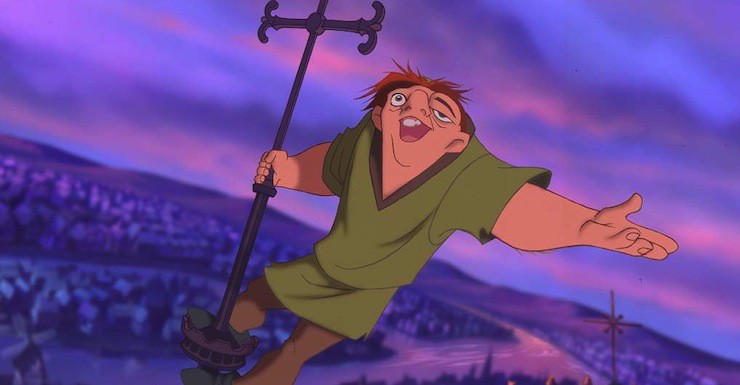By 1993, the Disney Animation department was finally—finally—flying high. The Little Mermaid, Beauty and the Beast, and Aladdin had all been solid hits, leading to talk of a “Disney Renaissance,” a term that would later be used to include all of the films from The Little Mermaid to Tarzan, or, for some Disney scholars, all of the films from The Great Mouse Detective to Fantasia 2000 except Oliver and Company. The Rescuers Down Under, if not exactly a hit, had at least allowed animators to develop and play with computer software that allowed for stunning new animated techniques, now being used for the finishing touches on a movie about a little lion that, ok, was just filler until the real prestige movie, Pocahontas, could be completed.
Still, the opening segment of that filler movie—a little scene involving a bird’s eye view of animals running across an African safari—and the sheer beauty of the initial background work and some of the storyboards for Pocahontas started giving directors Gary Trousdale and Alan Wise ideas. Their film, Beauty and the Beast, had often taken a serious approach, in between the sillier moments featuring a singing candlestick and a chipped tea cup, and been lauded as high art. What if they were to follow that success with another high concept, serious film—like, say, an animated adaptation of Victor Hugo’s Notre-Dame de Paris?
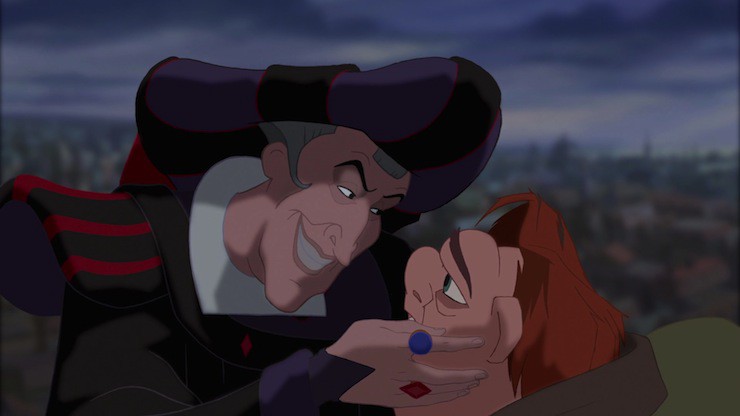
The choice was perhaps not entirely out of left field. The book had, after all, been made into a number of more or less successful film and television adaptations before this. More recently, the musical version of Victor Hugo’s Les Miserables, which had premiered in Paris in 1980 and in London in 1985, had become a global sensation, translated into multiple languages and becoming one of the longest running West End and Broadway productions of all time (although that little tidbit wasn’t yet known when the Disney film was in development). Since many of Disney’s animated films were, for all intents and purposes, Broadway musicals, a happy version of Hunchback of Notre Dame may have seemed a natural match.
At the same time, it was entirely out of left field, since Notre-Dame de Paris is emphatically not a story for children. Disney had, certainly, adapted some not particularly for children, or at least not young children, material before this—Bambi, The Fox and the Hound, and Who Framed Roger Rabbit all leap to mind. But none of these necessarily boded well for a child friendly Hunchback adaptation. Who Framed Roger Rabbit was an oddity for the studio, a live action/cartoon feature released with a PG rating (and partly a Spielberg production); The Fox and the Hound had to be completely overhauled to the point where it barely resembled the original novel; and Bambi, less overhauled, had left many small children in tears, when not completely traumatized.
And of all of these, Notre-Dame de Paris was perhaps the least suitable source for a children’s film, quite apart from the book’s length, what with the high death toll, multiple scenes of violence, a plot largely motivated by sexual obsession (not really a typical Disney theme), two people almost having sex right in front of a priest, and ongoing digressions about architecture, completely unsuited for animation.
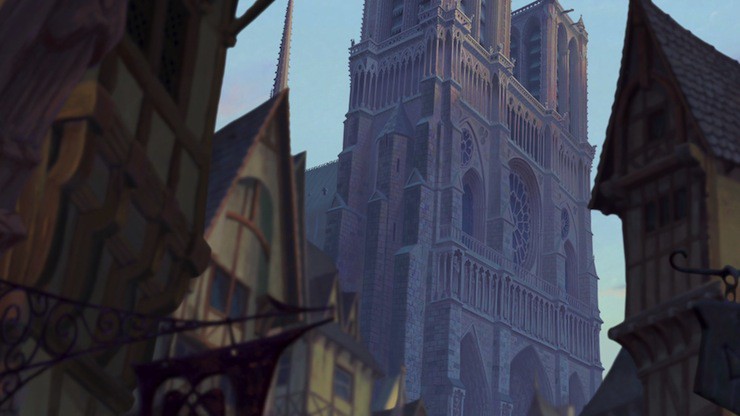
The studio could, of course, have tossed all of this, instead creating something like a second Oliver and Company—an amusing story, possibly focused on an ugly hunchback and the adorable goat he befriends—with almost no connection to the original apart from the name. But for whatever reason, perhaps a respect for the original, or perhaps too many conversations about how the 1939 version with Maureen O’Hara got it “wrong,” the animators avoided this. The animators also had the option to simply jettison any hope of a G rating, and instead plan the film for a PG rating, aiming it at a slightly older audience, as Disney had with The Black Cauldron. But here, directors ran straight into an insurmountable obstacle: Disney executives who well remembered the box office disaster that had been The Black Cauldron (a memory they were only finally able to overcome six years later, when approving Treasure Planet), and who demanded that the film retain its G rating.
It did, if only by severely stretching the definition of that G rating, and by making last minute changes to one scene—Frollo’s fantasy of Esmeralda dancing in the flames—after the MPAA raised numerous objections to images that suggested that Esmeralda was not wearing enough, or indeed any, clothing during that dance. That’s the sort of thing which might be expected to happen to any woman who decides to dance in the middle of a fire, but the MPAA was less sympathetic on this point, insisting that the scene suggested enough nudity to require at least a PG-13 rating. Animators managed to change the scene just before release.
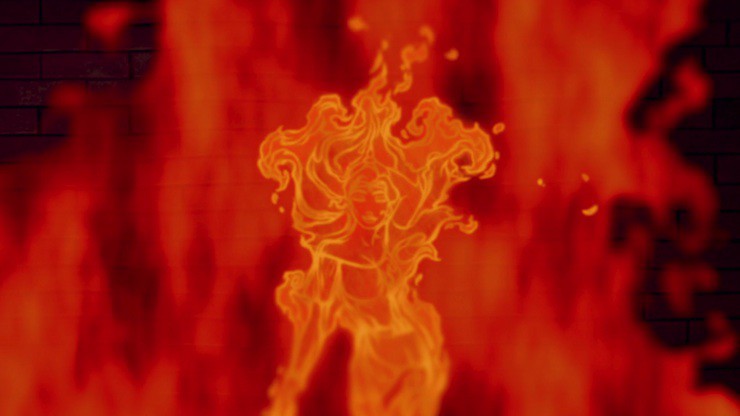
But very adult themes, including infanticide, sexual obsession, and religious obsession remained, creating an animated film with extensive, uncartoonlike violence: a woman killed in the first few minutes of the film; a family almost burned alive; a mob scene involving several soldiers and citizens hit by weapons and flying stones; and most of Paris set on fire. One of the film’s centerpiece songs, “Hellfire,” features terrifying demons and a seductive, sensuous dance. It’s one of only a very few sequences in Disney animated films to feature demons (the others are Fantasia’s “Night on Bald Mountain,” and a few bits coming up in The Princess and the Frog), and it may be the most terrifying of the three. The center romance is a love triangle, without any villains, one that does not go all that well for the main protagonist. And all of the characters, except for one or two cameo appearances from children, are definitely adults. Not young adults, as in other Disney films, but adults.
The result was an oddity in the Disney animated canon: an animated film marketed to children that does not necessarily feel that it’s for children. It’s also one of the darkest of Disney films, if not the darkest: The Black Cauldron, after all, featured monsters, not real people committing atrocities in the name of religion and justice; Bambi’s mother was shot offscreen, not killed on screen in the first six minutes of the film. The closest thematically to this is either Fantasia’s “Night on Bald Mountain” or Pinocchio. And none of these films had dealt directly with the issues of religion and sexual obsession.
This may help explain why, at some point during development, the producers decided to add three gargoyles to the film as comic relief. Partly, of course, the gargoyles were intended as toys (a promotional tie-in with Burger King did, in fact, sell them as toys), and they may also have been inspired by Gargoyles, the Disney cartoon which was airing as Hunchback was developed and animated. And, by the time Hunchback came around, it was almost impossible to conceive of a Disney film without a comedic sidekick, generally voiced by a famous comedian—in this case, Jason Alexander, then on Seinfeld, but also hired for his previous voice work and Broadway experience.
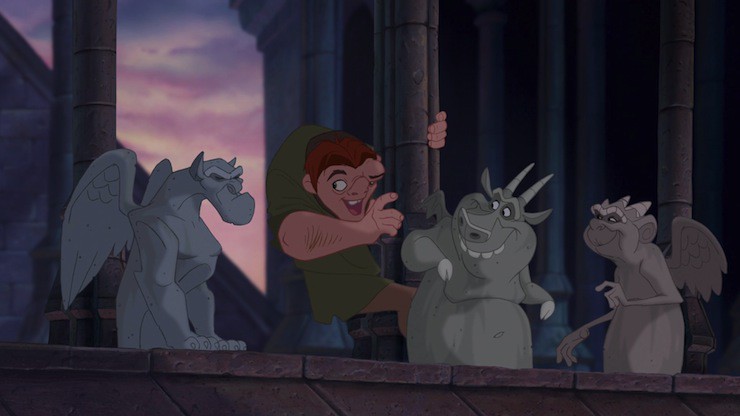
Adding comedy to darker material was, of course, hardly a new development—think of the gravedigger scene in Hamlet. But in this case, it’s an uneasy fit, perhaps best exemplified by the complete tonal dissonance of a scene relatively late in the film, when Frollo’s order to burn down Paris is immediately followed by the gargoyles breaking out into the big, cheerful Broadway number “A Guy Like You,” complete with dancing. To be clear, they’re singing about Quasimodo, not Frollo, and the song is mostly meant to showcase Jason Alexander’s very real Broadway talents, and in that sense it works, but the timing is beyond wrong: Paris is burning, Phoebus is badly injured, Esmeralda could be killed at any moment—and the gargoyles choose this moment to start tap dancing.
Ok then.
Ok, yes, the gargoyles are made of stone, which explains things—except that in other scenes, the gargoyles are depicted as (mostly) kind, caring individuals, and it seems incredible that they would have no interest in the tiny little fact that the city is burning up beneath them. Adding to the problem: the song encourages Quasimodo to think that he has an actual shot at Esmeralda, a hope that is immediately COMPLETELY CRUSHED by the VERY NEXT SCENE where Esmeralda and Phoebus end up making out right in front of him, leading to the tragic destruction of an innocent playing card and a crying Quasimodo, like, thanks, gargoyles, for giving him all that false hope.

Nor does it help that the film seems unsure about the exact status of the gargoyles. They turn into unmoving stone whenever anyone other than Quasimodo is around, and at one point, Quasimodo admits, in the dialogue, that the gargoyles are just stone, implying that their movement and conversation only exist in his imagination. In later scenes we see them having difficulty with affecting real objects other than the toys Quasimodo has created, or playing cards: they have problems helping Quasimodo move both Phoebus and Esmeralda, and are helpless to help Quasmiodo against Frollo. And yet, in later scenes, we see them throwing stones that knock out and injure the oncoming soldiers.
Speaking of which, remember when the major point of Notre-Dame de Paris was to convince people that the Cathedral of Notre Dame needed to be protected and preserved in all its glorious beauty as the greatest expression of human thought and achievement in Paris? And then remember the way in this film Hugo the gargoyle then cheers on the idea of BREAKING OFF BITS OF CAREFULLY CARVED STONE FROM THE CATHEDRAL TO USE THOSE STONES AS WEAPONS?
Er.
Yes, that’s all done in defense of the cathedral, but it’s still the single most jarring change from the book, made all the more jarring thanks to the one earlier scene that does focus on Notre Dame’s beauty, suggesting that it—and God—can defend the helpless. If bits of it are torn apart and used as weapons, AUUUGH.
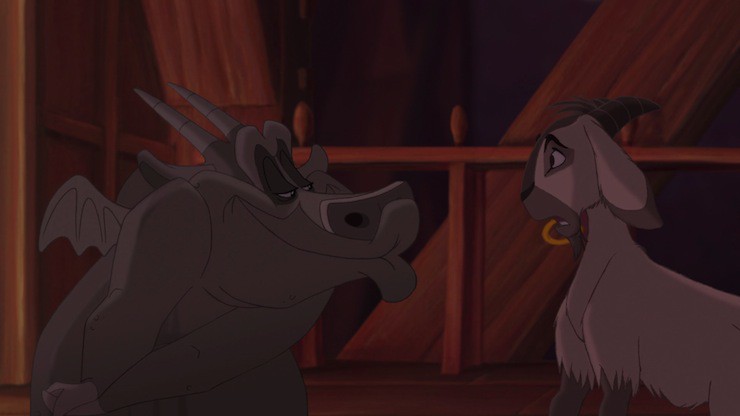
Having said all this, I must give the gargoyles credit for one thing: they’re responsible for one of Disney’s hands down best getting-crap-past-the-radar moment in any of their animated films, one I will admit I missed the first time around, when the very male Hugo falls in love—ok, in lust—with a goat. A male goat. A goat referred to, more than once, as a male. This is hardly the first or last time a Disney sidekick character has fallen hard for another Disney sidekick character (it’s almost a subplot of the film that follows this one), but it is the first time in a Disney animated film that a guy has fallen for a guy. Ok, sure, yes, Hugo is made of stone, and the goat is, well, a goat, but let’s take progress where we can get it. It’s also a nice nod to the book, where the very male poet Pierre Gringoire had had a similar—if not quite as lustful—reaction to the same goat.
And to be fair, here and there the film has a few nice nods to the book, suggesting that someone associated with the film did read it: for example, Phoebus’s complaint that Paris is always changing, meaning that he can never find his way around it, very close to a complaint made by a character, or more specifically Victor Hugo complaining through a character in the book. But for the most part, the film is more striking for the ways in which it changed certain elements of the book—while keeping the focus on sexual obsession and the many men who fall for Esmeralda.
For instance, religion. Victor Hugo’s primary interest had been in Notre Dame’s architecture, not its religious practices. His secondary interest was in portraying the hypocrisy of certain church officials, in the process displaying a certain cynicism about religion. In his novel, Frollo is as intrigued by alchemy as by God; his austerity comes as much from his studies, his personality, and his desire to provide for his rather useless brother as it does from anything found in the Bible. In the film, Frollo, changed from archdeacon to judge, is far more focused on religion and god, and the archdeacon (in the film a separate character) seems, in his very brief appearances, to be a genuinely good and holy man, though I have to question why, if this is indeed the case, the archdeacon seems to have left so much of Quasimodo’s life and upbringing up to Frollo, given that the archdeacon is perfectly aware of exactly what Frollo is: someone who has murdered in the cause of enforcing order.
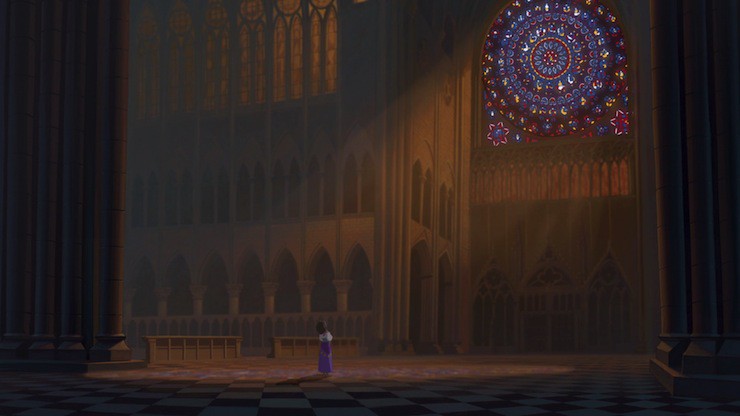
But the main religious moments center not on the archdeacon, but Esmeralda, singing “God Help the Outcasts,” as she wanders through Notre Dame, a hymn that both invokes God and decries racism and cruelty to people who, well, look different, like Quasimodo, which includes lingering looks at the religious images of Notre Dame. The song is usually read as a plea for tolerance towards minority viewpoints (and by some more cynical viewpoints, as the animation department’s way of responding to the various threats by U.S. religious rights organizations to organize boycotts of Disney, although the actual boycott, led by the Southern Baptist Convention, was not announced until the film was released). It’s not just one of the very few outright religious statements found in Disney animated films, which mostly avoid any discussion of religion whatsoever, but it’s in sharp contrast to the religious cynicism seen in the book.
The greatest change made to the book, however, was the ending, where instead of dying by hanging, and sharing a grave with Quasimodo, Esmeralda lives—and marries, not the ugly hunchback who saved her life and did Tarzan swings across crowds and smoke and fire for her, but the good looking Phoebus.
I don’t know that I could have expected more from the directors—who had, after all, ended Beauty and the Beast by transforming the Beast into a handsome prince (a moment later mocked in Shrek), even if that moment followed the fairy tale, and who were, after all, more or less working from a novel where Esmeralda did fall in love with Phoebus largely thanks to his looks, and later rejected Frollo in part because he wasn’t as good-looking as Phoebus. In that sense, the ending works as another nod to the original novel. I also have to applaud the film for letting Quasimodo accept Esmeralda’s choice with only a touch of jealousy and sullenness. This may be a film that treats its only major woman character as a sex object, with a villain that sings about how his sexual attraction to Esmeralda is destroying him, but it at least accepts, without question, that Esmeralda has the right to make her own choices, and does not look down on her for doing so. (In this one small way, it’s slightly better than the book.)
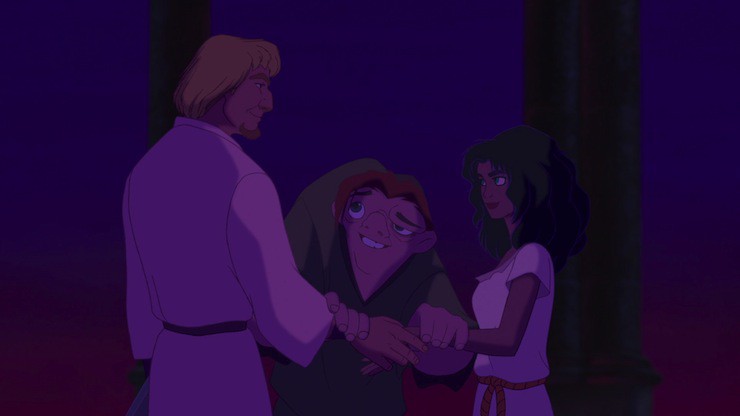
And, objectively speaking, Phoebus is probably a better match for Esmeralda in many ways than the shy, extremely sheltered Quasimodo, who, for the most part, has only seen the world from the top of the bell towers of Notre Dame. As I noted, he barely even seems to have spoken to the kindly archdeacon, who probably would have countered at least some of Frollo’s harsh words. Phoebus has travelled a lot outside of Paris, and, like Esmeralda, risked his life by refusing to obey orders that would harm the more helpless, and even jumped into a burning building to save two children. It’s all very brave, and he’s very handsome, and I can see exactly why Esmeralda would fall for him—
Except that the film wants me to cheer, not for Phoebus, but for Quasimodo. And given that this is also a film begging us, musically and visually, not to judge by appearances, having the lovely girl choose the handsome blonde guy instead of the ugly misshapen guy—well, it does make Quasimodo look even more heroic and self-sacrificing, but it also creates yet another dissonance in the film, this one even more uncomfortable than the gargolyes. And it doesn’t help that the film gives Quasimodo grander, riskier, and more heroic moments than it does Phoebus. I’m left with the distinct feeling that Esmeralda is not with the right guy, even if that guy does have the voice of Kevin Kline.
Speaking of voicing, this would be another issue with the film. Nothing is particularly terrible, except perhaps the distraction of hearing George Constanza—er, that is, Jason Alexander—giving relationship advice. But nothing, except arguably Tony Jay as Frollo, particularly stands out, either, and most of the voicing—especially Tom Hulce as Quasimodo and Demi Moore as Esmeralda, seems somehow restrained, not quite emotional enough. Also not quite working: Clopin, the leader of the gypsies, switching between narrative and character roles (he introduces the film and sings the conclusion), something that could have been intriguing if played with, but instead, Clopin is left a complete cipher.
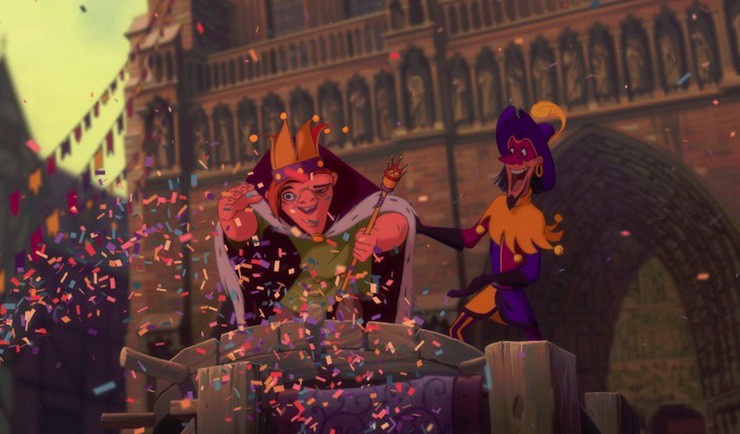
What can’t be faulted, however, is the animation. Hunchback may be the pinnacle of Disney’s hand drawn animated art, particularly during the “Hellfire” sequence, a combination of hand drawn animation and special effects that Disney never quite managed to top after this. Background artists visited Paris for inspiration and details; computer animators added the crowds and helped develop the sweeping camera movements. It looks lovely, and my frustrations with the film stem mostly from my thought that the art deserves better than the plot and voicing that it got: this could have been Disney’s greatest animated film, and yet, it isn’t.
All told, The Hunchback of Notre Dame cost about $70 million to make. It performed below expectations at the box office, bringing in just $100 million domestically and $353.2 million worldwide—more than enough to cover the film’s expenses, and far more than The Rescuers Down Under (the only box office failure of the Disney Renaissance period) but far below Aladdin and The Lion King, and even below Pocahontas, even by then considered a mild financial disappointment.
A planned direct-to-video sequel was delayed, and delayed again, all the way until 2002, when its release suggested that it probably should have been delayed still further. The then Disney-MGM Studios (now Hollywood Studios) showed a live, if shortened musical version of the film at the far, far back section of the park, which ran continuously until, probably not coincidentally, 2002. Frollo makes occasional appearances in Disney Villains products, and other Hunchback characters are sometimes featured in Disney pins (you really have to look, and for some inexplicable reason, at Walt Disney World the Hunchback pins are usually only available at, of all places, Animal Kingdom, which otherwise does not feature Hunchback merchandise or any connection to the film that I could discover. Why not in Epcot’s France pavilion next to the Ratatouille pins?) Some songs from the soundtrack—notably “The Bells of Notre Dame”—can sometimes be heard at Epcot.
Otherwise, the film disappeared from Disney merchandising.
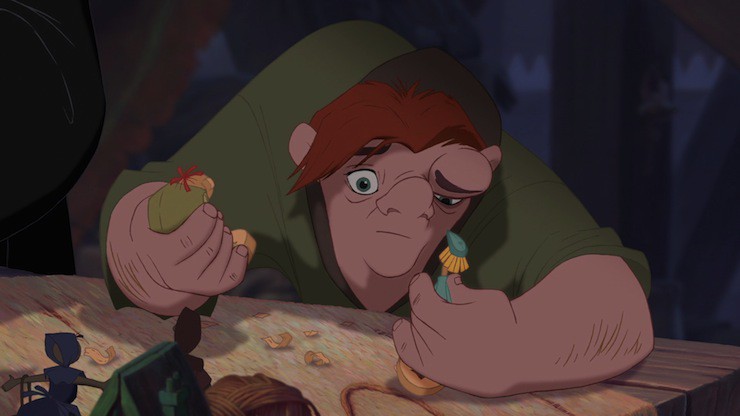
Coming right after the lukewarm response to Pocahontas, it was a severe setback to any hopes of continuing the idea of “high art” animation films, like Beauty and the Beast, Pocahontas, and Hunchback, two of which had been completely smashed at the box office by the comparatively “little,” less serious productions of Aladdin and The Lion King. Not to mention the stunning box office success of a little experimental film done by those computer guys who had helped out the Disney animators now and again—Toy Story.
It was, in a very real sense, the start of the end of the Disney Renaissance. But the Animation Studio still had a couple of high concept films in development. Oh, not the one featuring pirate ships in space, fun though that sounded. No, a little film that would be using new computer software, Deep Canvas—it would work well for showing something like, say, swinging through trees while giving a loud yell. Plus, this film for girls that had been handed over to the Florida animators—the ones originally set up to be a tourist attraction, now trusted to do their very own film about China.
But first, something silly, something that could convince audiences that Disney could be pure fun again. No, definitely not the pirate ships in space. Something more heroic.
Next up, Hercules.
Mari Ness lives in central Florida.










